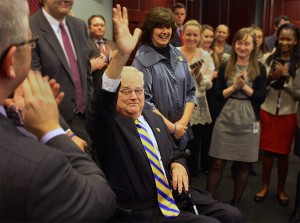FEB. 13, 2015 — The Democratic Congressional Campaign Committee (DCCC) released its first group of Frontline program incumbents for the 2016 election cycle. These 14 representatives are viewed to be the most vulnerable of Democratic House incumbents, and a group that the DCCC is highlighting for increased outside support.
Some are more endangered than others, in addition to a group of four who is at least entertaining the idea of running statewide next year. Not having an incumbent in these marginal districts may be the Committee leadership’s greatest fear.
Clearly Competitive (in vulnerability order)
NE-2: Rep. Brad Ashford is likely the most endangered Democratic incumbent. The new congressman unseated eight-term Rep. Lee Terry (R-Omaha) in a vote that may have been more about the previous incumbent’s unpopularity than Ashford. The 2016 race, in a year when the district should vote Republican at the presidential level, could be more difficult for Ashford than his original election.
FL-2: Freshman Rep. Gwen Graham ran a strong campaign against a weak Republican incumbent. She will undoubtedly draw strong opposition, and the district will almost assuredly go Republican for president. The national trends at the time of the next election will play heavily upon how this congressional race unfolds.
Continue reading >


